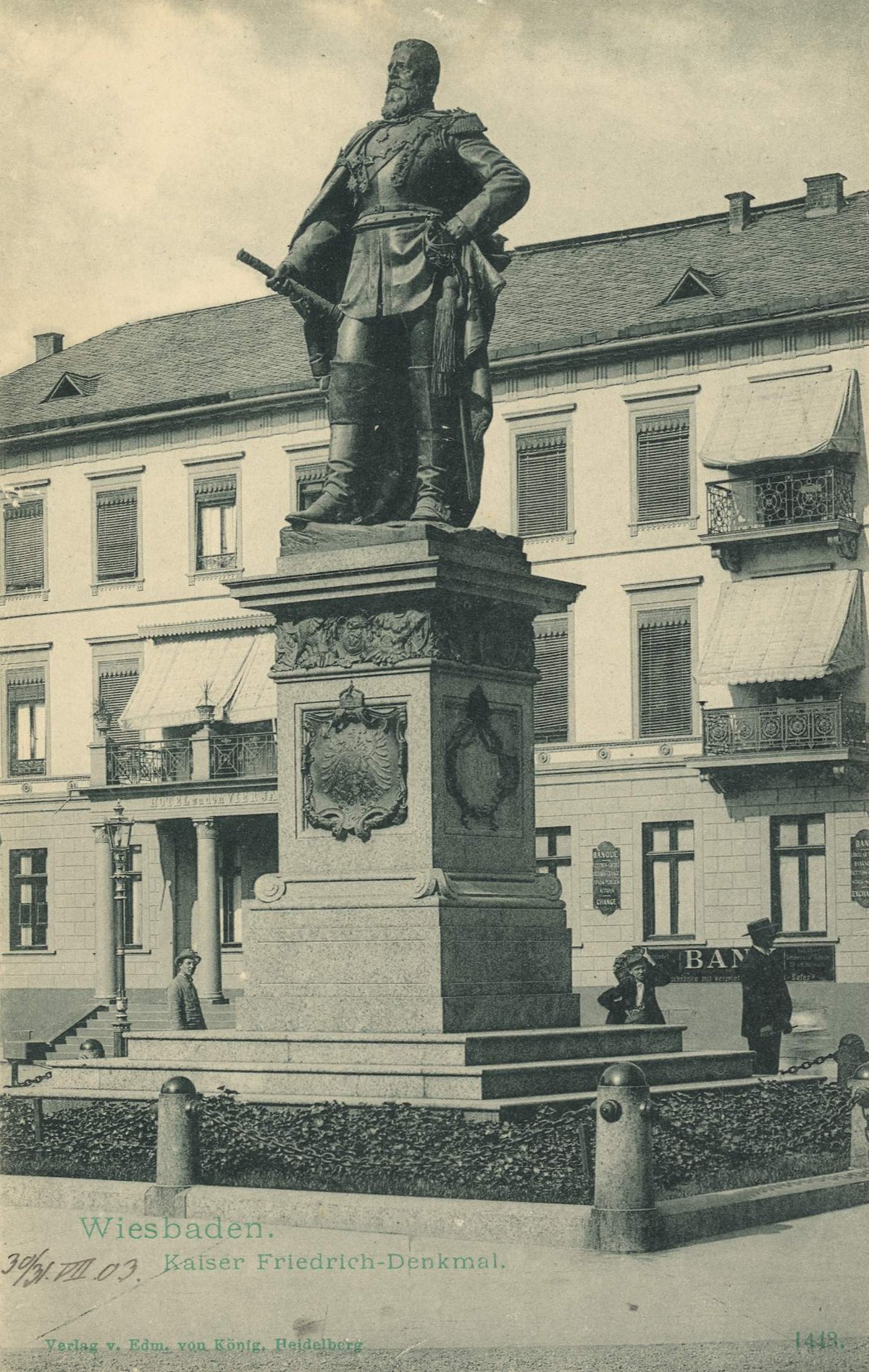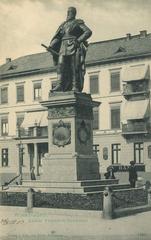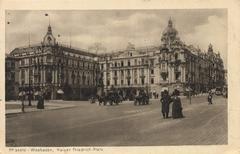
Kaiser Friedrich Memorial Wiesbaden: Visiting Hours, Tickets, and Historical Significance
Date: 14/06/2025
Introduction
Nestled in the elegant spa city of Wiesbaden, Germany, the Kaiser Friedrich Memorial (Kaiser-Friedrich-Denkmal) stands as a compelling testament to the nation’s imperial history and cultural heritage. Dedicated to Emperor Frederick III—whose brief but impactful 99-day reign in 1888 marked the dawn of liberal aspirations and constitutional reform—the memorial offers visitors an immersive window into the pivotal “Year of the Three Emperors.” Wiesbaden itself, famed for its 26 thermal springs and long-standing appeal as a spa destination for European nobility, provides the perfect backdrop where wellness, nobility, and political legacy intertwine.
The memorial’s late 19th-century architecture, enriched with imperial iconography such as eagles and laurel wreaths, is prominently sited within the serene Kurpark and along Wilhelmstraße, Wiesbaden’s prestigious boulevard. Its thoughtful integration into the urban landscape reflects a city where historical monuments coexist harmoniously with vibrant civic life (Wiesbaden Tourism; Mapcarta; Springer Link). This guide explores the memorial’s history, architectural features, visitor information—including hours, tickets, and accessibility—as well as practical tips and nearby attractions, ensuring every visitor can fully appreciate one of Wiesbaden’s most iconic sites.
Contents
- Introduction
- Origins and Historical Context
- Imperial Patronage and Spa Culture
- Architectural Features and Symbolism
- Visiting Information: Hours, Tickets, Accessibility
- Guided Tours and Events
- Practical Visitor Tips
- Urban Placement, Landscape, and Conservation
- Cultural Significance and Community Identity
- FAQs
- Conclusion and Call to Action
Origins and Historical Context
The Kaiser Friedrich Memorial commemorates Emperor Frederick III (Kaiser Friedrich III), a significant—though often overshadowed—figure in German imperial history. His reign in 1888, the “Year of the Three Emperors,” was marked by progressive ideals and an emphasis on constitutional reform, tragically curtailed by his untimely death from throat cancer. Wiesbaden’s legacy as a favored spa city for royalty, including Friedrich III himself, further elevates the memorial’s significance within the city’s 2,000-year history.
Imperial Patronage and Wiesbaden’s Spa Culture
Wiesbaden’s status as a spa destination is deeply intertwined with its imperial connections. Its 26 thermal springs, with waters ranging from 47°C to 67°C, drew European aristocracy in search of health and leisure. The construction of landmarks such as the Kurhaus (completed in 1907) reinforced Wiesbaden’s image as a center of elegance and imperial festivity. The Kaiser Friedrich Memorial reflects this heritage, symbolizing the city’s fusion of wellness, nobility, and political legacy.
Architectural Features and Symbolism
Design and Materials
The memorial features classical design elements typical of the late 19th century, combining durable stone and bronze. The statue, created by renowned Berlin sculptor Joseph Uphues, depicts Emperor Frederick III in military regalia, exuding dignity and resolve. His posture, adorned with a sword and a draped cloak, bridges the roles of military leader and enlightened monarch.
Artistic Details
Imperial motifs—eagles, crowns, and laurel wreaths—adorn the monument, reinforcing its commemorative intent. The stone pedestal features inscriptions that pay tribute to the emperor’s brief yet influential legacy. The memorial’s orientation and scale harmonize with surrounding architecture, from the neoclassical Hotel Nassauer Hof to the green expanse of the Kurpark (tourismus.wiesbaden.de; mapcarta.com).
Visiting the Kaiser Friedrich Memorial: Hours, Tickets, Accessibility
- Visiting Hours: The memorial is accessible year-round, 24 hours a day. For optimal experience and safety, visiting between 8:00 AM and 8:00 PM is recommended.
- Tickets: No admission fee is required. Access to the memorial and its surrounding park is free of charge.
- Accessibility: Wheelchair-friendly pathways surround the memorial. Public transportation (bus lines 1, 3, and 6) serves the area; Wiesbaden’s main train station is a 10-minute walk away. Limited street parking is available nearby.
- Guided Tours and Events: Guided walking tours—including the memorial and nearby historical sites—are available through the Wiesbaden Tourist Information Office. The site also hosts commemorations and cultural events throughout the year.
Practical Tips for Visitors
- Best Times: The plaza is lively during spring and summer, especially on weekends and during city events. Early morning and late afternoon offer the best lighting and a quieter atmosphere.
- Nearby Attractions: Within walking distance are the Kurhaus, Bowling Green, Kurpark, Marktkirche, Hessian State Theatre, and pedestrian shopping streets lined with cafes and restaurants.
- Photography: Photography is allowed at the memorial and in the surrounding park.
- Visitor Amenities: Public restrooms are available in the adjacent Kurpark. The area is well-signposted and pedestrian-friendly.
Urban Placement, Landscape, and Conservation
Spatial Context
The memorial’s prominent location on Wilhelmstraße, next to the Kurhaus and Kurpark, exemplifies 19th-century urban planning ideals. Its placement at a vital intersection connects key cultural and civic sites, reflecting theories advocated by Camillo Sitte for integrating monuments to enhance social and aesthetic value (Springer Link).
Landscape Integration
Surrounded by landscaped gardens and mature trees, the memorial’s open space provides a seamless transition from the city’s formal grid to the organic Kurpark layout. This layering of cultural and natural value aligns with the UNESCO Historic Urban Landscape approach (Springer Link).
Conservation
The memorial is protected under the Hessian Monument Protection Act and undergoes regular maintenance. Conservation efforts are guided by international best practices, ensuring the site’s enduring significance within Wiesbaden’s evolving cityscape.
Cultural Significance and Community Identity
The Kaiser Friedrich Memorial is more than a tribute to an individual ruler—it is a symbol of the city’s imperial past and civic values. Its location, atop the former base of the Schiller Monument, demonstrates the city’s respect for layered history and collective memory. The memorial features in educational initiatives and public ceremonies, reinforcing its role in Wiesbaden’s civic life and community identity.
Frequently Asked Questions (FAQ)
Q: What are the visiting hours?
A: The memorial and park are open 24 hours daily; daylight hours (8:00 AM to 8:00 PM) are recommended.
Q: Is there an entrance fee?
A: No, visiting the memorial is free.
Q: Is the site wheelchair accessible?
A: Yes, smooth pathways and accessible routes are provided.
Q: Are guided tours available?
A: Yes, through the Wiesbaden Tourist Information Office.
Q: How do I get there via public transport?
A: Bus lines 1, 3, and 6 stop nearby; the main train station is a 10-minute walk.
Q: Is parking available?
A: Limited street parking is nearby; public transport is recommended.
Q: Are there COVID-19 restrictions?
A: Check official Wiesbaden tourism resources for current guidelines.
Conclusion and Call to Action
The Kaiser Friedrich Memorial stands as a vibrant symbol of Wiesbaden’s imperial heritage, architectural elegance, and urban vitality. Its central location, free access, and integration with the city’s cultural landscape make it a must-visit for history enthusiasts, architecture lovers, and curious travelers alike.
Plan your visit to experience Wiesbaden’s rich history firsthand. For more information, visit the official Wiesbaden tourism website and consider downloading the Audiala app for guided tours and interactive maps. Follow local social media channels for updates on events and exhibitions near the memorial.
Images:
Alt text: Kaiser Friedrich Memorial Wiesbaden surrounded by Kurpark greenery.
Alt text: Map showing the location of Kaiser Friedrich Memorial and nearby landmarks in Wiesbaden.
Explore more about Wiesbaden’s cultural landmarks at Wiesbaden Tourism.
Sources and Further Reading
- Kaiser Friedrich Memorial Wiesbaden: History, Visiting Hours, Tickets & Visitor Guide, 2025, Wiesbaden Tourism (https://tourismus.wiesbaden.de/entdecken/sehenswertes/denkmaeler)
- Visiting the Kaiser Friedrich Memorial in Wiesbaden: Hours, Tickets, and Historical Insights, 2025, Wiesbaden Tourism (https://tourismus.wiesbaden.de/entdecken/sehenswertes/denkmaeler)
- Kaiser-Friedrich-Therme Visiting Hours, Tickets, and Visitor Guide in Wiesbaden, 2025, Mattiaqua Official Site (https://www.mattiaqua.de/en/thermal-springs/kaiser-friedrich-therme/)
- Visiting the Kaiser Friedrich Memorial in Wiesbaden: Hours, Tickets, and Nearby Attractions, 2025, Wiesbaden Official Tourism (https://www.wiesbaden.de/en/tourism)
- Mapcarta - Kaiser Friedrich Memorial Location, 2025 (https://mapcarta.com/N1863194962)
- Springer Link - Urban Planning and Cultural Heritage in Wiesbaden, 2025 (https://link.springer.com/chapter/10.1007/978-3-031-54816-1_7)












































































